Birdfinding.info ⇒ Uncommon and declining across most of its range—now only a rare visitor to Japan. Some areas where it still breeds in numbers include: the Selenge Delta along the southern shore of Lake Baikal; eastern Mongolia in the Kurkh Valley and around Tashgain and Buir Lake; and Wuerquihan, Inner Mongolia. During migration it is regularly found at several sites along the Chinese coast—including Long Valley (Hong Kong), Nanhui Dongtan (Shanghai) and Beidaihe (Hebei)—and near Beijing at Guanting, Shahe, and Miyun Reservoirs. In Hawaii, it is most often found on the northern and western slopes of Mauna Kea, especially at Pu’u La’au.
Japanese Quail
Coturnix japonica
Breeds in northeastern Asia. Winters mainly in temperate and subtropical eastern Asia. Populations declined precipitously from the late 1900s into the 2000s.
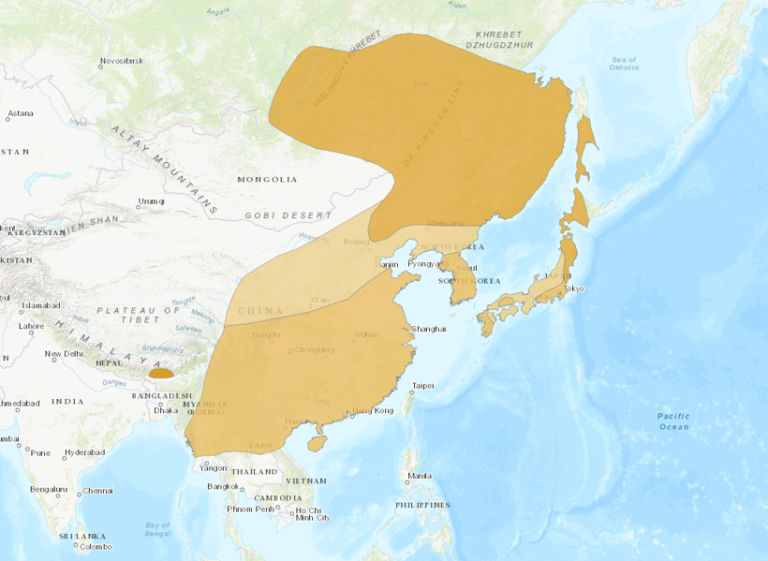
Traditional range of the Japanese Quail. © BirdLife International 2016
Breeding. Steppes and meadowlands of east Mongolia (west to Khangain Nurru National Park), northeastern China, adjacent portions of the Russian Far East, and at least formerly east to Sakhalin, Hokkaido, and northern Honshu.
Its remaining strongholds appear to be: (1) north-central Mongolia and southern Buryatia (Lake Baikal region); and (2) eastern Mongolia and west-central Inner Mongolia.
Elsewhere it apparently still breeds locally in small numbers eastward into Heilongjiang and the southeastern territories of Russia (Amur Oblast, Primorsky Krai, and Khabarovsk Krai), and south to Hebei and Lioaning. Farther east on Sakhalin and Hokkaido, the few isolated reports in the 2000s seem to indicate that it has vanished as a regular breeder.
Nonbreeding. Winters mainly in eastern China from Hebei and Lioaning to Guangdong. Formerly common but now rare in winter east to the Korean Peninsula and Japan, and south to eastern India and the northern portions of Myanmar, Thailand, Laos, and Vietnam, and Taiwan.
Small numbers remain on the breeding grounds all winter—or until the arrival of heavy snow or extreme cold pushes them south.
Movements. Migrates north mainly in March and April, and south in October and November, but movements are difficult to detect because many individuals remain scattered throughout migratory pathways. Winter overshots have been recorded in Cambodia and the Philippines.
Residents. A non-migratory population has been found breeding on southern slopes of the Himalayas in Bhutan and possibly farther east, as there have been reports of confirmed or likely breeders in Assam and northern Myanmar.
Another small, apparently non-migratory population is known from the lowlands of eastern Sichuan around Chengdu, but its status is in doubt.
Introductions. Introduced populations are established in Hawaii on the Big Island and more tenuously on Kauai, the result of releases on all the main Hawaiian Islands during the 1930s. It is possible that small populations persist undetected on some of the other islands.
Widespread introductions in Europe and North America have generally failed, except for a population reportedly established in northern Italy—although its continued presence there does not appear to be well documented.
Identification
A mostly brownish, cryptically mottled quail. Usually appears warm-brown and buffy overall, often with rufous-chestnut streaks on the chest and sides.
Not reliably distinguished by sight from Common Quail. Like Common and other Coturnix quails, Japanese has a pronounced whitish or buffy brow that extends back to its nape, and spiky streaks on its upperparts and sides.
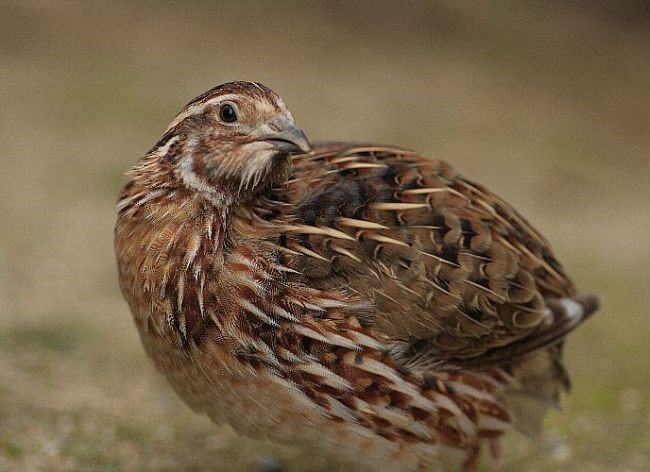
Japanese Quail, male molting into breeding plumage. (Osaka, Japan; April 13, 2008.) © Nobuo Matsumura
Male’s breeding plumage is distinctive, as the face, throat, and upper chest take on a ruddy flush—the color varies from orangey to brick-red to brown.
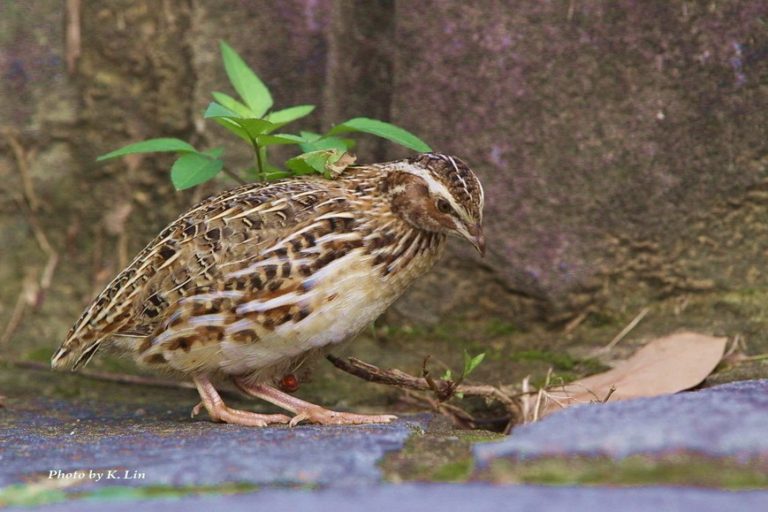
Japanese Quail, male in breeding plumage with mostly brown face. © Kevin Lin

Japanese Quail, male in breeding plumage showing brick-red face and buffy breast. (Ka’ohe Game Management Area, Big Island, Hawaii; June 9, 2018.) © Margaret Sloan
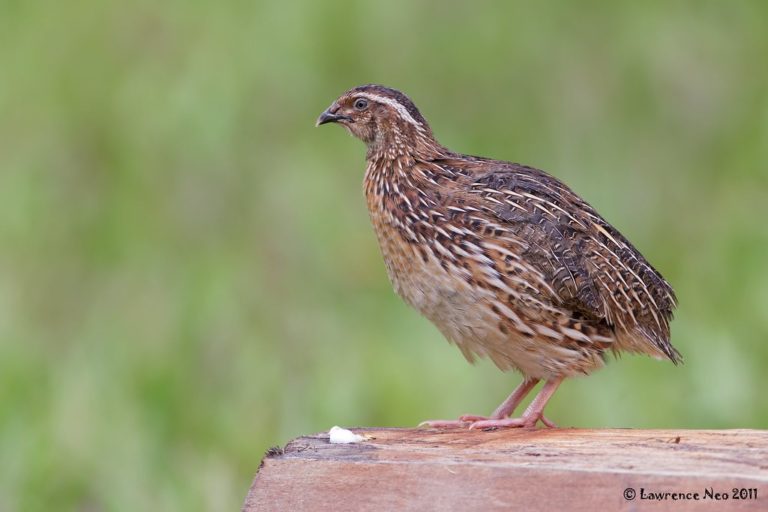
Japanese Quail, male showing partial breeding plumage. (2011.) © Lawrence Neo
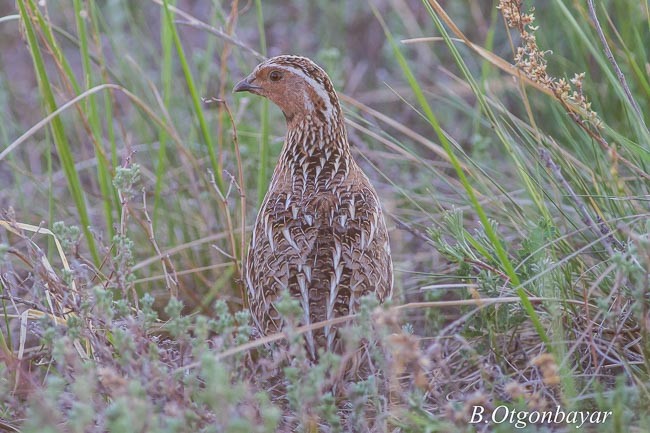
Japanese Quail, male in breeding plumage, showing orange-brown face. (Khalk Gol, Dornod, Mongolia; June 2, 2015.) © Baatargal Otgonbayar

Japanese Quail, male in breeding plumage, showing brick-red face. (Khalk Gol, Dornod, Mongolia; June 2, 2015.) © Yann Muzika

Japanese Quail, male in breeding plumage showing ruddy reddish-brown face and throat—also note central crown streak. (Summer Palace, Beijing, China; April 27, 2015.) © Jesper Hornskov
Females and non-breeding males have somewhat variable markings on the face and throat—typically an indistinct “mask,” a short, well-defined whisker, dark and pale streaks on the neck, and a partial collar across the throat.
Females typically have more extensively pale throats, whereas males usually show some remnants of the reddish-brown breeding plumage.
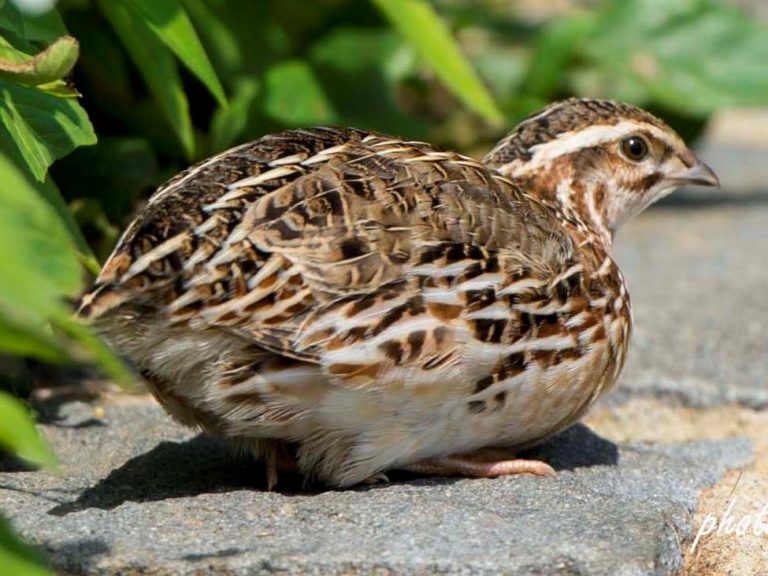
Japanese Quail, female. (Yeliu Geopark, New Taipei City, Taiwan; October 18, 2013.) © Jimmy Yao

Japanese Quail, female showing rufous-chestnut streaks on sides. (Darĭganga, Suhbaatar, Mongolia; November 28, 2017.) © Ariuka
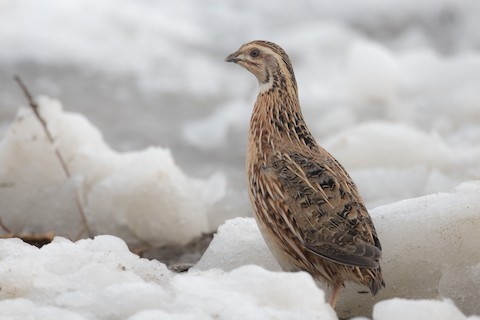
Japanese Quail. (Lake Izunuma, Kurihara, Miyagi, Honshu, Japan; January 8, 2020.) © Yann Muzika
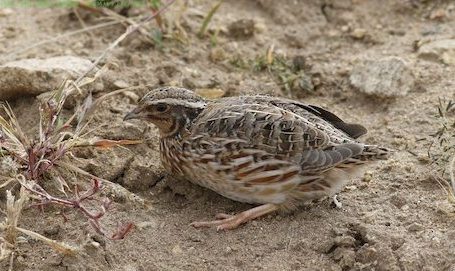
Japanese Quail, female. (Baganuur, Hentiy, Mongolia; September 14, 2017.) © Ariunbaatar Barkhasbaatar
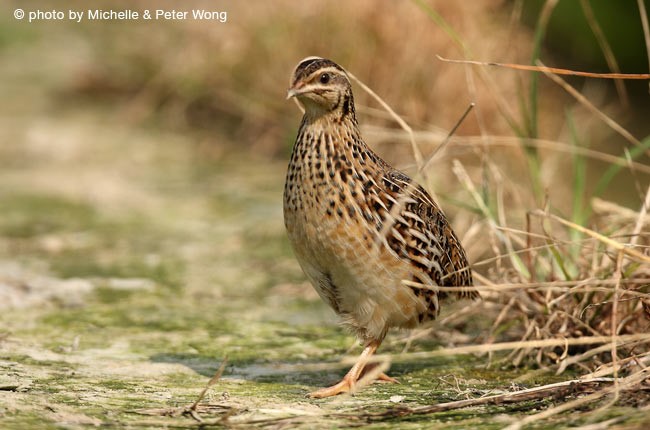
Japanese Quail, female showing generally buffy underparts. (Long Valley, Hong Kong; October 24, 2009.) © Michelle & Peter Wong
Immatures resemble adults but are typically grayer overall, closer to black-and-white, lacking the rusty and buffy tones of adults.
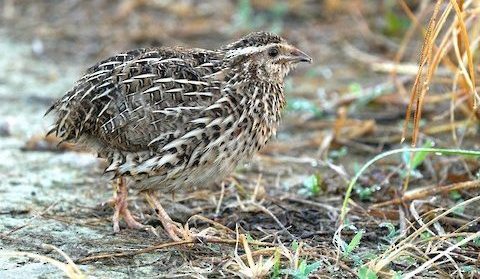
Japanese Quail, immature showing that its spiky pale streaks are truly spiky feathers. (Long Valley, Hong Kong; November 10, 2019.) © Roman Lo

Japanese Quail, either a “cold-plumaged” female or a very early immature. (Khalk Gol, Dornod, Mongolia; June 2, 2015.) © Yann Muzika

Japanese Quail, female. (Jiamusi, Heilongjiang, China; July 25, 2014.) © John Howes
In flight, the wings appear pale to medium-brown, with fine barring visible on the flight feathers when seen well.
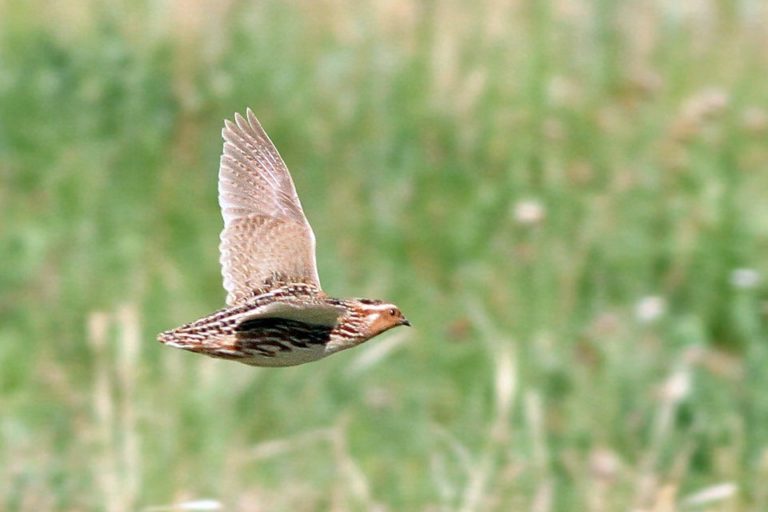
Japanese Quail, male in breeding plumage, in flight. (Bayanmod, Hentiy, Mongolia; June 21, 2012.) © Jeremiah Trimble
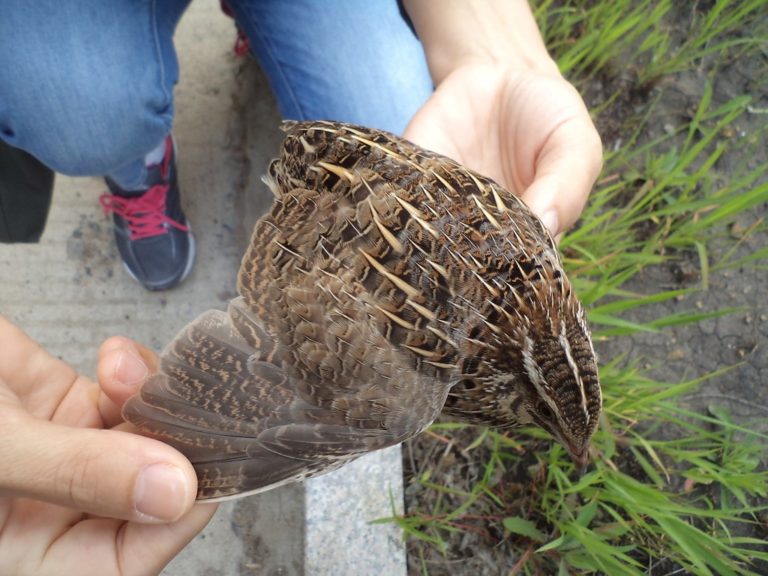
Japanese Quail, female showing details of upperparts and wing patterns. (Jiamusi, Heilongjiang, China; July 25, 2014.) © John Howes
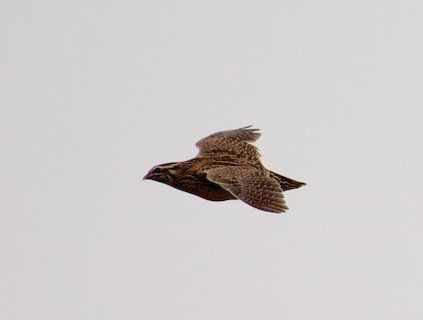
Japanese Quail, in flight, showing fine barring on flight feathers. (Nanhui Dongtan, Shanghai, China; January 1, 2019.) © Yasuhiko Komatsu
Cf. Common Quail. Common and Japanese Quails are very similar western and eastern counterparts that overlap to some extent on their central Asian breeding grounds and in winter in eastern India and adjacent countries. Japanese Quail is typically somewhat darker and richer-colored than the populations of Common Quail that occur closest to it, but Common is sufficiently variable to invalidate any guidance for distinguishing the two by visible features.
Voice is the most reliable means of distinguishing the two. Both give brief three-syllable calls, but Common’s is fluid whereas Japanese’s is harsher and more reverberant.
Notes
Monotypic species.
IUCN Red List Status: Near Threatened.
References
BirdLife International. 2016. Coturnix japonica. The IUCN Red List of Threatened Species 2016: e.T22678949A95209097. https://dx.doi.org/10.2305/IUCN.UK.2016-3.RLTS.T22678949A95209097.en. (Accessed March 18, 2020.)
Brazil, M. 2009. Birds of East Asia. Princeton University Press, Princeton, N.J.
eBird. 2020. eBird: An online database of bird distribution and abundance. Cornell Lab of Ornithology, Ithaca, N.Y. http://www.ebird.org. (Accessed March 18, 2020.)
Madge, S., and P.J.K. McGowan. 2002. Pheasants, Partridges, and Grouse: A Guide to the Pheasants, Partridges, Quails, Grouse, Guineafowl, Buttonquails, and Sandgrouse of the World. Princeton University Press, Princeton, N.J.
McGowan, P.J.K., and G.M. Kirwan. 2020. Japanese Quail (Coturnix japonica). In Handbook of the Birds of the World Alive (J. del Hoyo, A. Elliott, J. Sargatal, D.A. Christie, and E. de Juana, eds.). Lynx Edicions, Barcelona. https://www.hbw.com/node/53433. (Accessed March 18, 2020.)
Pratt, H.D. 1993. Enjoying Birds in Hawaii: A Birdfinding Guide to the Fiftieth State (Second Edition). Mutual Publishing, Honolulu, Hawaii.
Pyle, R.L., and P. Pyle. 2017. The Birds of the Hawaiian Islands: Occurrence, History, Distribution, and Status. Version 2 (January 1, 2017). http://hbs.bishopmuseum.org/birds/rlp-monograph/. B.P. Bishop Museum, Honolulu, Hawaii.
Xeno-Canto. 2020. Japanese Quail – Coturnix japonica. https://www.xeno-canto.org/species/Coturnix-japonica. (Accessed March 18, 2020.)
